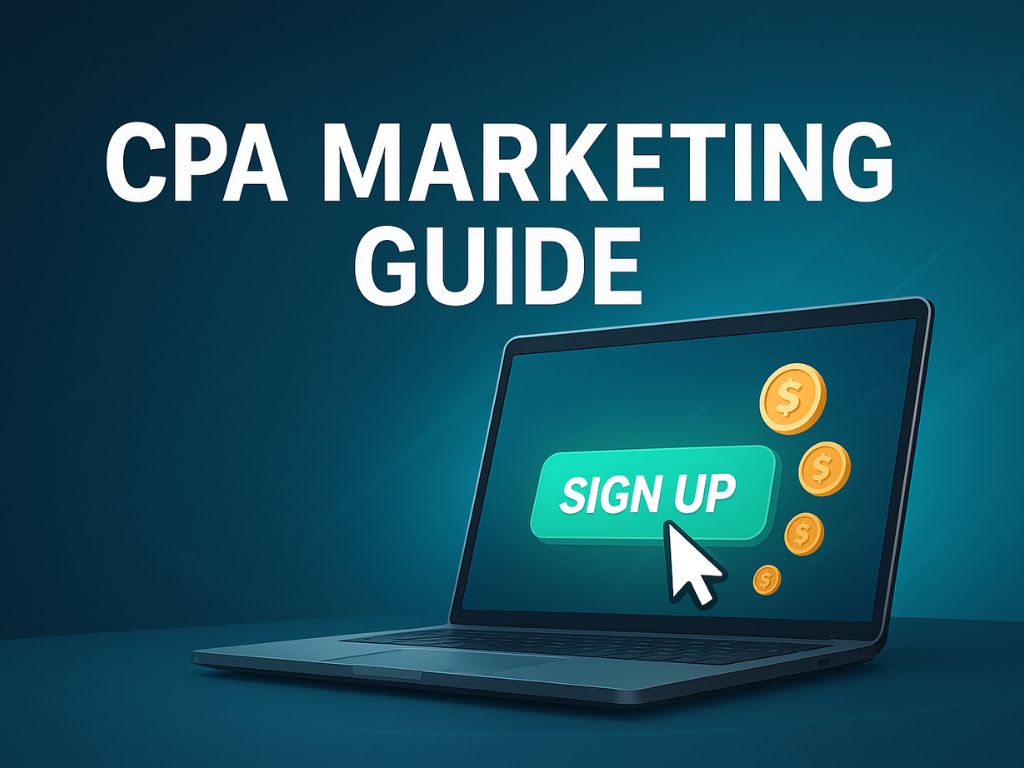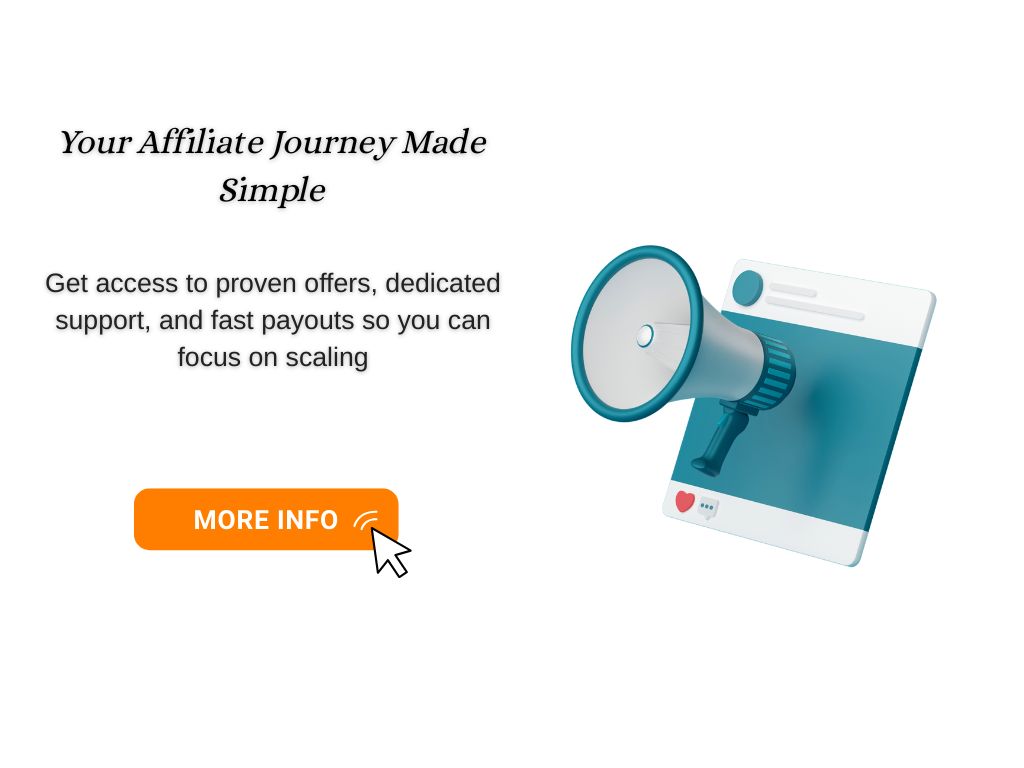CPA Marketing for Beginners: The Guide to Earning Online
Dreaming of a flexible way to earn online? Our ultimate guide demystifies CPA (Cost Per Action) marketing, making it accessible even if you’s a complete beginner.
Discover how to tap into lucrative online opportunities by driving specific actions, not just sales, and build a sustainable income stream from scratch without needing prior experience.

What Exactly is CPA Marketing? Your Beginner’s Definition
Imagine you’re a digital matchmaker. That’s essentially what you are in the world of CPA marketing!
CPA stands for Cost Per Action. At its core, CPA marketing is a performance-based advertising model where you, as an affiliate (often called a ‘publisher’), get paid a commission every time a user completes a specific action.
Here’s the exciting part: Unlike traditional affiliate marketing, where you often need to drive a direct sale to earn, CPA broadens the scope of what qualifies for a payout. This “action” can be anything from:
- Filling out a form: (e.g., for an insurance quote, a free consultation)
- Signing up for a free trial: (e.g., for a software service, a streaming platform)
- Submitting an email address: (e.g., to join a newsletter, download a free e-book)
- Downloading an app: (e.g., a mobile game, a productivity tool)
- Making a phone call: (e.g., to a car dealership, a home service company)
- Even just watching a video!
Think of it this way: A company (the ‘advertiser’ or ‘merchant’) wants more leads, sign-ups, or engagement. They’re willing to pay you, the affiliate, for each instance of a desired action. Your job is to connect interested users with these offers, guiding them to complete that specific action. Once they do, and it’s verified, you earn your agreed-upon commission.
It’s a straightforward, “you scratch my back, I’ll pay you” model that can be incredibly lucrative because the barrier to entry for the user is often much lower than making a full purchase. You’re simply connecting the right people to the right opportunities, and getting paid handsomely for it!
Why CPA Marketing is Your Go-To for Earning Online
So, why should CPA marketing be at the top of your list when exploring online income streams, especially if you’re just starting out?
Here’s why this model is a game-changer:
- Lower Barrier to Entry (for Users & You!): We’ve touched on this, but it’s crucial. Users don’t need to open their wallets to convert. This means they are far more likely to complete an action like filling out a form or signing up for a free trial than making an immediate purchase. Higher user conversion rates mean higher earnings potential for you! Plus, as an affiliate, you don’t need your own product, inventory, or complex sales funnels to get started.
- Diverse Earning Opportunities: The sheer variety of CPA offers is astounding. From health and finance to gaming and software, there’s a niche for almost any interest. This allows you to explore different markets, find what resonates with your audience, and diversify your income streams without being tied to a single product or service.
- No Product Creation or Customer Service Headaches: Forget about developing your own products, managing inventory, shipping, or dealing with customer support. Your role is to connect interested users with relevant offers. Once the action is completed and verified, your job is done, and your commission is on its way. This frees you up to focus purely on traffic generation and optimization.
- Scalability and High ROI Potential: Once you find a winning offer and a traffic source that converts, CPA marketing is incredibly scalable. You can increase your ad spend, expand your traffic channels, and replicate your successful strategies across multiple offers. The potential for a significant return on investment (ROI) is substantial, especially as you hone your marketing skills.
- Performance-Based & Transparent: This model is entirely based on results. Advertisers only pay when a desired action occurs, and you only get paid when you deliver that action. This transparency ensures that everyone’s incentives are aligned, fostering a fair and efficient ecosystem for earning online.
In essence, CPA marketing offers a relatively straightforward path to earning online by leveraging existing products and services. It minimizes common entrepreneurial hurdles, allowing you to focus on what you do best: connecting people with opportunities and getting rewarded for it.

How CPA Marketing Works: The Simple A-Z Process
Understanding the mechanics of CPA marketing is simpler than you might think. It’s a well-oiled machine involving a few key players and a clear sequence of events. Here’s a breakdown of the typical A-Z process:
The Key Players
Before diving into the steps, let’s quickly identify the main characters in this story:
- The Advertiser (or Merchant): This is the company or business that has a product or service and wants more leads, sign-ups, or sales. They’re the ones offering the “action” and willing to pay for it.
- The Affiliate (or Publisher): That’s you! You’re the marketer who promotes the advertiser’s offers.
- The CPA Network: This acts as the intermediary. It’s a platform that connects advertisers with affiliates, hosts thousands of offers, handles tracking, and manages payouts. Think of it as a marketplace for CPA offers.
- The User (or Customer): The person who completes the desired action.
The Simple A-Z Process
- Advertiser Creates an Offer: A company (the advertiser) decides they want a specific action from users – perhaps more email sign-ups for their newsletter, free trial registrations for their software, or leads for an insurance quote. They set a commission rate they’re willing to pay for each completed action.
- Offer is Listed on a CPA Network: The advertiser partners with a CPA network and lists their offer on the platform. The network then makes this offer available to its approved affiliates, detailing the action required, the payout per action, geo-targeting restrictions (e.g., US only), and any other specific terms.
- Affiliate Joins a CPA Network: As an aspiring CPA marketer, your first step is to apply and get approved by one or more CPA networks (e.g., MaxBounty, ClickDealer, PeerFly). Once approved, you gain access to their marketplace of offers.
- Affiliate Selects an Offer: You browse through the available offers, looking for those that align with your interests, target audience, and marketing strategy. You consider the payout, the ease of conversion, and the relevance to your chosen niche.
- Affiliate Promotes the Offer: This is where your marketing skills come into play! You choose a traffic source (e.g., social media ads, search engine marketing, native ads, email marketing, content marketing) and create compelling ad copy, landing pages, or content designed to attract your target audience. Your goal is to send interested users to the advertiser’s offer page via your unique affiliate tracking link.
- User Completes the Action: An interested user clicks on your affiliate link, lands on the advertiser’s page (or your pre-lander), and performs the specific action required by the offer – fills out a form, signs up for a free trial, downloads an app, etc.
- Tracking and Verification: The CPA network’s sophisticated tracking system (using cookies, pixels, or server-to-server postbacks) immediately records this action. The advertiser then verifies that the action is legitimate (e.g., not a bot, valid information provided). Once verified, the action is marked as a “conversion.”
- Affiliate Gets Paid: As soon as the conversion is approved, your CPA network account is credited with the agreed-upon commission. Networks typically have payment thresholds and schedules (e.g., weekly, bi-weekly, or monthly payouts) where your accumulated earnings are transferred to you via various payment methods like PayPal, wire transfer, or Payoneer.
And just like that, you’ve successfully connected an interested user with an advertiser’s offer and earned a commission! Your focus then shifts to optimizing your campaigns, scaling what works, and finding new profitable offers.

Key Players: Who’s Who in the CPA Marketing World
To truly grasp how CPA marketing works, it helps to know who’s who in this bustling online ecosystem. Think of it as a play with four main characters, each with a vital role to fulfill:
The Advertiser (or Merchant)
This is the business, brand, or company that has a product, service, or goal they want to achieve. They could be a software company wanting more free trial sign-ups, an insurance provider seeking new lead forms, a mobile game developer aiming for app downloads, or an e-commerce store looking for newsletter subscriptions.
- Their Goal: To acquire more leads, sales, sign-ups, or engagement for their business, but only pay when a specific, desired action is completed.
- Their Role: They create the “offer,” define the specific action they want users to take, set the commission rate they’re willing to pay per action, and ultimately verify if the completed actions are legitimate. They’re the ones with the goods (or services!) who are ready to pay for results.
The Affiliate (or Publisher)
That’s YOU! You’re the digital marketer, the entrepreneur, the one who connects the dots. Your role is to find potential customers (users) who are interested in what the Advertiser is offering and guide them to complete the desired action.
- Your Goal: To earn commissions by successfully driving users to complete the Advertiser’s specified action.
- Your Role: You select offers from CPA networks, craft compelling marketing campaigns (using ads, content, social media, etc.), drive targeted traffic to the advertiser’s offer page (or your own pre-lander), and optimize your campaigns for maximum conversions. You’re the matchmaker, the traffic generator, the one making the connection.
The CPA Network
Consider the CPA Network as the central hub, the marketplace, and the indispensable middleman that brings Advertisers and Affiliates together. They provide the infrastructure, the tracking technology, and the administrative support to make the whole system run smoothly. Examples include well-known networks like MaxBounty, ClickDealer, and PeerFly.
- Their Goal: To facilitate successful partnerships between Advertisers and Affiliates, ensuring both sides achieve their objectives.
- Their Role: They host thousands of offers from various Advertisers, make these offers available to approved Affiliates, handle all the sophisticated tracking of conversions, manage commission payouts to Affiliates, and often provide support and resources. They act as the trusted broker, ensuring transparency and accountability for everyone involved.
The User (or Customer)
This is the person on the other end of the screen – your target audience, the potential customer, the individual who will ultimately complete the action. They’re browsing the internet, looking for solutions, entertainment, information, or new products/services.
- Their Goal: To find something of value, whether it’s a free trial, an interesting e-book, an insurance quote, a useful app, or just information.
- Their Role: They click on your promotional material, land on the Advertiser’s offer page, and perform the specific action (e.g., fill out a form, sign up, download). Their action is the trigger that earns you your commission. Without the user, there are no conversions, and no payouts!
Finding Your Niche & The Best CPA Offers for Beginners
You’ve learned the mechanics, understood the players, and now you’re itching to dive in. But before you start blindly promoting every offer you see, there’s a crucial step that can make or break your CPA marketing journey: finding your niche and identifying the right offers for beginners.
Trying to be everything to everyone in the vast world of online marketing is a recipe for overwhelm and minimal results. By narrowing your focus, you can become an expert in a specific area, understand your audience deeply, and craft highly targeted campaigns that convert.
Why Finding Your Niche is Non-Negotiable
- Less Competition: When you go broad, you’re competing with seasoned marketers with huge budgets. A niche allows you to carve out your own space.
- Targeted Audience: You’ll understand their pain points, desires, and language, making your marketing messages far more effective.
- Easier Content Creation: It’s simpler to create engaging content (ads, blog posts, social media updates) when you’re focusing on a specific topic.
- Higher Conversion Rates: When your offer perfectly aligns with your audience’s needs, they’re much more likely to take action.
- Build Authority: Over time, you can become a trusted resource in your chosen niche, leading to more organic traffic and conversions.
How to Uncover Your Perfect Niche
Finding your niche isn’t about reinventing the wheel; it’s about finding an intersection of interest, demand, and profitability.
- Start with Your Passions & Interests: What topics genuinely excite you? What do you spend time learning about? Marketing something you understand and care about will be far more enjoyable and sustainable.
- Identify Problems You Can Solve: People search online for solutions. Think about common problems in areas like:
- Health: Weight loss, fitness, specific ailments.
- Wealth: Making money online, saving money, investing.
- Relationships: Dating, self-improvement.
- Hobbies: Gaming, crafting, pet care.
- Research Market Demand:
- Google Trends: See if interest in your chosen topics is growing or declining.
- CPA Networks: Browse offers on popular networks. What categories have a lot of active offers? This indicates advertiser demand.
- Competitor Analysis: What are other successful affiliates promoting? Don’t copy, but draw inspiration.
- Consider Profitability: Look for niches where advertisers are willing to pay decent commissions. While your initial focus should be learning, keep an eye on earning potential.
What Makes a CPA Offer “Beginner-Friendly”?
Once you have a niche in mind, it’s time to pick offers. For beginners, the goal is to get conversions quickly, learn the ropes, and build confidence, even if the payout isn’t massive.
Look for offers that have:
- Low Barrier to Entry for the User:
- Email Submits: Users only need to enter their email address.
- Zip/Postal Code Submits: Often used for sweepstakes or local offers.
- Free Trials: Users get immediate value without paying upfront.
- App Installs: Simple download and open.
- Lead Generation (simple forms): Offers like “get a free quote” where the form is short.
- Broad Appeal within Your Niche: While you’re niching down, choose offers that aren’t too obscure initially.
- Reputable Advertisers: Stick to well-known brands or offers that appear professional and trustworthy. This reduces user skepticism and increases conversion rates.
- Clear & Concise Landing Pages: The advertiser’s page should be easy to navigate, clearly explain the offer, and have a prominent call to action.
- Good EPC (Earnings Per Click) or CR (Conversion Rate) (if available): CPA networks often provide data on how well an offer is performing for other affiliates. Look for offers with higher numbers, but take them with a grain of salt as a beginner.
- Geo-Targeting You Understand: Start with offers targeted to your own country or a country whose culture and language you are familiar with.
Top Beginner-Friendly CPA Offer Categories
Here are some popular and often successful categories for those just starting out:
- Sweepstakes & Freebies: These are incredibly popular because the user’s action is minimal (often just an email or zip code submit) and the reward (e.g., a chance to win an iPhone, a free sample) is highly appealing.
- Example Offers: “Win a $1000 Gift Card,” “Get a Free Sample of X Product.”
- Software & SaaS Free Trials: Many software companies offer free trials (e.g., VPNs, antivirus, productivity tools). Users get to test a valuable service, and you get paid for the signup.
- Example Offers: “Try [VPN Service] Free for 7 Days,” “Download [Antivirus Software] Free Trial.”
- Mobile App Installs: With the prevalence of smartphones, promoting app installs (games, utility apps, social apps) can be very lucrative. The action is quick and easy for the user.
- Example Offers: “Install [Popular Mobile Game],” “Download [Productivity App].”
- Lead Generation (Simple): This involves collecting user information for a service. Focus on offers where the form is short and the value proposition is clear.
- Example Offers: “Get a Free Insurance Quote,” “Find Out Your Home’s Value,” “Sign Up for a Free Consultation.”
- Dating Offers: These often involve free sign-ups or profile creations on dating sites. They tap into a universal human desire and can convert well with the right audience.
- Example Offers: “Join [Dating Site] for Free,” “Find Local Singles Now.”
Remember, the key for beginners is to start small, test different offers within your chosen niche, analyze your results, and learn what resonates with your audience. Don’t chase the highest payouts initially; chase conversions and knowledge.

Joining a CPA Network: Your First Big Step
You’ve got your niche, identified beginner-friendly offers, and understand the core mechanics. Now, how do you actually get access to these lucrative opportunities? The answer lies in joining a CPA network. This isn’t just a formality; it’s your gateway to the world of CPA marketing, connecting you directly with advertisers and their offers. Think of it as getting your membership card to the exclusive club where all the deals are made.
Why Joining a CPA Network is Crucial
CPA networks serve as the indispensable bridge between advertisers and affiliates. They handle the complex backend operations – everything from hosting thousands of offers, providing unique tracking links, verifying conversions, and managing your payouts. Without a network, you’d have to individually contact companies, negotiate terms, and set up your own tracking, which is simply not feasible for beginners (or most experienced affiliates for that matter!).
What to Look for in a Beginner-Friendly CPA Network
Not all networks are created equal, especially when you’re just starting out. Here’s what to prioritize:
- Reputation and Trustworthiness: This is paramount. You want a network that pays on time, has a solid history, and is respected in the industry. Do a quick Google search for reviews before applying.
- Offer Variety Relevant to Your Niche: While you’re starting with beginner-friendly offers, ensure the network has a good selection within your chosen niche(s).
- Payment Terms and Thresholds: Check their payment schedule (weekly, bi-weekly, monthly) and the minimum payout threshold. Some networks have higher thresholds (e.g., $500), which can be harder for beginners to reach initially. Look for networks with lower thresholds (e.g., $50-$100).
- Affiliate Manager Support: A good affiliate manager can be a game-changer. They can guide you to top-performing offers, provide insights, and help troubleshoot issues. Look for networks known for responsive and helpful support.
- Intuitive User Interface: As a beginner, you want a platform that’s easy to navigate, where you can easily find offers, track your stats, and access resources.
- Tracking and Reporting: Ensure the network provides robust, real-time tracking and detailed reports so you can monitor your campaign performance accurately.
Top Recommended CPA Networks for Beginners
While there are hundreds of CPA networks, some stand out for their beginner-friendliness, offer variety, and reliable payouts.
- MaxBounty: One of the most reputable and well-established networks. They have a vast array of offers across many niches and are known for their excellent affiliate managers and on-time payments. They do have a slightly more involved application process, but it’s worth the effort.
- ClickDealer: Another major player with a global reach. They offer a diverse range of verticals, including dating, sweepstakes, and mobile, which are great for beginners. They also have a strong reputation for support.
- AdWork Media: Specializes in content locking and incentive-based offers, which can be very beginner-friendly. They have a user-friendly interface and a good selection of email/zip submits and mobile app installs.
- CPAGrip / CPALead: Similar to AdWork Media, these networks are excellent for content locking and offer a wide variety of easy-to-convert offers, often with lower payout thresholds, making them ideal for new affiliates looking for quick wins.
- PeerFly (Currently operating under new ownership as PeerClick): Was a top-tier network with a great reputation for beginner support. While its ownership has changed, the underlying platform for tracking and offers remains robust, and it’s still a strong contender.
Pro Tip: Don’t just apply to one! It’s wise to apply to 2-3 networks. This increases your chances of approval and gives you a wider selection of offers to choose from.
The Application Process: Your First ‘Interview’
Getting approved by a CPA network is your first mini-challenge. Networks want to ensure you’re a legitimate marketer who will drive quality traffic, not spam. Here’s how the process typically unfolds:
- Fill Out the Application Form: This is usually a detailed online form asking for your personal information, marketing experience, preferred niches, traffic sources you plan to use, and how you intend to promote offers.
- Be Honest: Don’t exaggerate your experience. It’s okay to be a beginner; just state your intentions clearly.
- Be Detailed: Provide as much information as possible. “I’ll use social media” isn’t enough. “I plan to create Instagram ad campaigns targeting users interested in fitness for health-related free trial offers” is much better.
- Prepare for the Interview (Often a Phone Call/Skype): Many reputable networks will require a brief interview with an affiliate manager. This is where they get to know you, verify your information, and assess your potential.
- What to Expect: They’ll ask about your experience (even if it’s minimal), your chosen niche, your planned traffic sources (e.g., Facebook Ads, Google Ads, native ads, SEO), how you plan to drive traffic to offers, and why you want to join their network.
- Your Strategy: Have a clear, concise plan ready. Even if you’re new, show you’ve done your research. For example, “I’m focusing on the gaming niche, and I plan to run Facebook Ads targeting mobile game enthusiasts for app install offers. I’ve researched some basic ad creatives and landing page strategies.”
- Show Enthusiasm: Let them know you’re serious about learning and making CPA marketing a success.
- Approval or Denial: If approved, congratulations! You’ll gain access to their dashboard and a world of offers. If denied, don’t despair. Ask why, learn from it, and apply to another network. Sometimes, it’s just about finding the right fit.
Tips for Getting Approved (and Starting Strong!)
- Be Professional: Use a professional email address (e.g., yourname@gmail.com, not gamerdude69@hotmail.com).
- Have a Plan: Even if it’s a basic one, know your niche and your intended traffic sources. This shows you’re serious.
- Be Honest About Experience: It’s okay to be a beginner. Many networks appreciate honesty and are willing to work with motivated new affiliates.
- Show You’ve Done Your Homework: Mention that you’ve researched CPA marketing, understand what an “action” is, and know what you’re looking for.
- Don’t Lie About Traffic Sources: If you say you have a massive email list or a high-traffic website and you don’t, they will find out. Start with what you genuinely plan to use.
- Ask Questions: During the interview, don’t be afraid to ask about their best-performing offers for beginners or any resources they provide. This shows engagement.
Getting approved by your first CPA network is a significant milestone. It validates your commitment and unlocks the tools you need to start earning. Once you’re in, take your time to explore the dashboard, familiarize yourself with the offers, and don’t hesitate to reach out to your affiliate manager for guidance. They are there to help you succeed!

Common CPA Marketing Mistakes Beginners Make (And How to Avoid Them)
Even with the clearest guides and the best intentions, every beginner stumbles. CPA marketing is no exception. The good news? Many common pitfalls are entirely avoidable if you know what to look out for. Learning from others’ mistakes can save you significant time, money, and frustration.
Here are some of the most common CPA marketing mistakes beginners make, and crucial advice on how to steer clear of them:
1. Not Researching the Offer (or Advertiser) Enough
The Mistake: You find an offer with a juicy payout, grab your link, and start driving traffic without thoroughly vetting it. You don’t check the advertiser’s landing page quality, read the offer terms carefully, or investigate the advertiser’s reputation.
How to Avoid It:
- Inspect the Landing Page: Click through your affiliate link. Is the advertiser’s landing page professional, clear, and easy to navigate? Does it load quickly? A poor landing page will kill your conversion rate, no matter how good your traffic is.
- Read the Offer Terms (TL;DR is not an option): Pay close attention to geo-targeting (e.g., US only), allowed traffic sources (e.g., no incentivized traffic), and any specific restrictions. Violating these terms can lead to denied commissions or even getting banned from the network.
- Talk to Your Affiliate Manager: They are your best resource! Ask them about the offer’s performance, if it’s converting well for other affiliates, and any tips they might have.
- Check Reviews (if possible): A quick search for the advertiser might reveal if they have a history of rejecting leads or poor customer service, which can impact your success.
2. Ignoring Traffic Source Rules and Compliance
The Mistake: You jump onto Facebook Ads or Google Ads without understanding their advertising policies. You directly link to offers that are against their terms of service, leading to ad account bans, lost ad spend, and a damaged reputation.
How to Avoid It:
- Master the TOS: Before launching any campaign, thoroughly read and understand the advertising guidelines of your chosen traffic source (e.g., Facebook Ads Policies, Google Ads Policies, native ad network rules).
- Use Pre-landers Wisely: A pre-lander (or bridge page) is a page you create before sending users to the advertiser’s offer. This allows you to:
- Pre-sell: Warm up the user, build interest, and explain the offer’s value.
- Filter: Qualify users, ensuring only genuinely interested ones click through to the offer.
- Comply: Create content that aligns with the traffic source’s rules, even if the final offer page is a bit more aggressive.
- Avoid Misleading Claims: Don’t make exaggerated promises in your ads or pre-landers that the offer can’t deliver. Honesty builds trust and leads to higher quality conversions.
3. Not Testing, Tracking, and Optimizing
The Mistake: You run a campaign, it doesn’t perform well, and you either give up or keep throwing money at it without understanding why it’s failing. You don’t track your results, or you make drastic changes based on gut feelings instead of data.
How to Avoid It:
- Start Small and Test: Don’t blow your entire budget on one campaign. Begin with small test budgets for different ad creatives, headlines, targeting options, and even different offers.
- Track Everything: Use the tracking provided by your CPA network, and consider implementing your own tracking solution (like Voluum, RedTrack, or even simple UTM parameters) for more granular data. Track clicks, conversions, cost per click (CPC), cost per action (CPA), and return on investment (ROI).
- A/B Test Continuously: Change one element at a time (e.g., ad image, headline, call to action, pre-lander copy) and compare the results. Data-driven decisions are the only way to scale profitably.
- Analyze Your Data: Look for patterns. Which demographics convert best? Which ad copy resonates most? At what point are users dropping off?
4. Chasing High Payouts Over Conversions
The Mistake: You see an offer paying $100 per lead and ignore an offer paying $5 for an email submit. You assume higher payouts mean higher profits, but these offers often have much stricter requirements or are harder to convert.
How to Avoid It:
- Focus on Conversion Rate First: For beginners, the goal is to get conversions, learn the process, and build confidence. A $5 offer with a 10% conversion rate is far more valuable for learning than a $100 offer with a 0.1% conversion rate.
- Understand User Intent: Offers with higher payouts typically require more commitment from the user (e.g., credit card details, extensive forms). Offers with lower payouts usually have a lower barrier to entry for the user, making them easier to convert.
- Build Momentum: Start with easy-to-convert offers to generate some initial commissions. This builds your confidence and provides capital to invest in testing higher-payout offers later.
5. Not Understanding Your Audience
The Mistake: You promote a “weight loss” offer to a broad audience without segmenting. Your ads are generic, and you don’t speak to the specific pain points or desires of potential users.
How to Avoid It:
- Deep Dive into Demographics & Psychographics: Who are you trying to reach? What are their age, gender, location, interests, income level? More importantly, what are their problems, fears, and aspirations related to your offer?
- Craft Targeted Messaging: Your ad copy and pre-lander content should directly address your audience’s needs. Use language they understand and resonate with.
- Use Specific Targeting Options: Leverage the targeting capabilities of your ad platforms (e.g., interest targeting on Facebook, keyword targeting on Google) to reach the most relevant users.
6. Giving Up Too Soon
The Mistake: Your first few campaigns don’t turn a profit, and you conclude that CPA marketing “doesn’t work” or that you’re “not cut out for it.”
How to Avoid It:
- Embrace the Learning Curve: CPA marketing is a skill that takes time and effort to develop. Expect to lose money on some initial campaigns – consider it your “education budget.”
- Persistence is Key: Successful affiliates are those who analyze failures, adapt their strategies, and keep testing. Every “failed” campaign provides valuable data that brings you closer to a winning one.
- Join Communities: Engage with other affiliates in forums or groups. You’ll realize everyone faces challenges, and you can learn from their experiences and get support.
7. Direct Linking Without a Strategy
The Mistake: You send users directly from your ad to the advertiser’s offer page, missing an opportunity to pre-qualify, warm up, or filter your traffic. While some traffic sources and offers allow direct linking, it’s often not the most profitable approach for beginners.
How to Avoid It:
- Utilize Pre-landers (Bridge Pages): As mentioned, pre-landers are invaluable. They allow you to:
- Build Rapport: Tell a story, share a testimonial, or provide more context.
- Pre-qualify: Filter out users who aren’t a good fit, saving the advertiser (and potentially you) from low-quality leads.
- Increase Conversion Rates: A well-crafted pre-lander can significantly improve the conversion rate on the advertiser’s page by preparing the user.
- Adhere to Compliance: It’s often easier to get ads approved on platforms like Facebook or Google if you’re linking to your own compliant pre-lander first.
- Know When Direct Linking Works: Direct linking sometimes works for very simple offers on specific traffic sources (e.g., pop traffic, push notifications) where the user is already “primed” for a quick action. But for most beginners, a pre-lander is a safer and often more profitable bet.
By being aware of these common pitfalls and actively working to avoid them, you’ll set yourself up for a much smoother and ultimately more successful journey in the exciting world of CPA marketing. Learn from others, stay patient, and keep optimizing!

Scaling Your Efforts: Turning Small Wins into Big Income
Once you’ve tasted that first sweet success – a few conversions, a positive ROI on a small test campaign – you’re no longer just a beginner; you’re an affiliate with momentum. The real magic of CPA marketing lies in its scalability. Turning those small, initial wins into a substantial income stream is a systematic process of analysis, optimization, and expansion.
Here’s how to scale your CPA marketing efforts and watch your earnings grow:
1. Master Your Data: The Blueprint for Scaling
Before you even think about spending more, you need to understand why your initial wins happened. Your tracking data is your most valuable asset.
- Deep Dive into Analytics: Go beyond just seeing conversions. Analyze:
- Which ad creatives/headlines performed best? What messaging resonated most?
- Which targeting parameters (demographics, interests, placements) yielded the highest ROI?
- What time of day or day of the week were conversions most frequent?
- Which pre-lander variations led to the highest click-through rates to the offer?
- What was your EPC (Earnings Per Click) and CR (Conversion Rate) for each segment?
- Identify Winning Combinations: Look for the specific blend of ad creative, targeting, pre-lander, and offer that consistently delivers profitable results. This “winning combo” is your foundation for scaling.
2. Optimize for Maximum Profitability
Scaling isn’t just about spending more; it’s about spending smarter. Fine-tune your existing campaigns to squeeze out every possible drop of profit.
- Aggressive A/B Testing: Continuously test variations of:
- Ad Copy & Creatives: New images, videos, headlines, calls-to-action.
- Pre-landers: Different angles, benefits, layouts, and hooks.
- Landing Page Elements (if you control them): Even small changes can have a big impact.
- Negative Targeting: Identify what isn’t working and cut it.
- Keywords (for search ads): Exclude non-converting or irrelevant search terms.
- Placements (for display/native ads): Block websites or apps where your ads show but don’t convert.
- Demographics/Interests: Exclude age groups, genders, or interests that are burning cash without conversions.
- Bid Adjustments: Optimize your bids based on performance. Increase bids for high-performing segments and decrease or cut bids for underperformers.
3. Gradually Increase Your Ad Spend (The “Vertical Scale”)
Once you have a profitable campaign, the most direct way to scale is to increase your budget on that specific campaign.
- Go Slow to Go Fast: Don’t double your budget overnight. Increase your daily spend incrementally (e.g., 10-20% at a time) and monitor performance closely. Rapid scaling can sometimes disrupt algorithms or saturate an audience, leading to diminishing returns.
- Maintain ROI: As you increase spend, keep a keen eye on your ROI. If your profitability starts to drop significantly, you might be hitting a saturation point or need to re-optimize.
- Expand Targeting Within the Same Platform: If a specific interest group is converting well, try to find similar or related interest groups on the same traffic source (e.g., if “yoga enthusiasts” work, test “meditation practitioners”).
4. Replicate Success Across New Offers & Niches (The “Horizontal Scale”)
Don’t put all your eggs in one basket. Take your proven strategies and apply them elsewhere.
- Find Similar Offers: If a “free VPN trial” offer is converting well, look for other VPN offers on the same or different CPA networks. Advertisers often have multiple offers for the same product or similar products.
- Explore Related Niches: If you’re crushing it in the “weight loss” niche, consider branching out to “muscle gain” or “healthy eating” offers. Your audience insights and marketing skills are transferable.
- Test New CPA Networks: Once you have a track record, apply to more reputable CPA networks. This gives you access to a wider variety of offers, potentially better payouts, and more affiliate managers who can guide you to top performers.
5. Diversify Your Traffic Sources
Relying on a single traffic source is risky. Ad account bans, policy changes, or increased competition can wipe out your income overnight.
- Expand to New Platforms: If you’re winning on Facebook Ads, start testing Google Ads, native ads (e.g., Taboola, Outbrain), push notifications, or even TikTok Ads. Each platform has its own audience and rules, but your core marketing principles remain.
- Consider Organic Traffic: For long-term, sustainable growth, invest in content marketing and SEO. Building a blog or YouTube channel around your niche can generate free, high-quality traffic that converts well and isn’t subject to ad platform policies.
- Email Marketing: Build your own email list by offering a valuable lead magnet (e.g., a free guide, checklist). An email list is a highly valuable asset you own, allowing you to promote multiple offers over time without ongoing ad spend for traffic acquisition.
6. Leverage Tools and Automation
As your campaigns grow, managing everything manually becomes impossible.
- Affiliate Trackers: Tools like Voluum, RedTrack, or Binom are essential for advanced tracking, split-testing, and optimizing across multiple traffic sources and offers.
- Spy Tools: Services like AdPlexity or Anstrex can help you see what other affiliates are promoting and how they’re doing it, providing inspiration and competitive intelligence.
- Automation Scripts: Some ad platforms allow for automation rules (e.g., pause ads if CPA is too high, increase bids at certain times).
Scaling is an iterative process. It involves continuous learning, testing, and adapting. Don’t be afraid to experiment, but always let data guide your decisions. By systematically applying these strategies, you can transform those initial small wins into a robust and scalable online income with CPA marketing.

Your Ultimate Action Plan: Starting Your CPA Journey Today
You’ve absorbed the knowledge, understood the mechanics, and seen the immense potential. Now, it’s time to transform that understanding into action. CPA marketing isn’t just a theory; it’s a practical skill that you build by doing. Don’t let analysis paralysis hold you back. Follow this ultimate action plan to kickstart your journey and begin earning online today!
Step 1: Discover Your Niche & Identify Beginner-Friendly Offers (Revisit & Refine)
This is your foundation. Don’t skip or rush it.
- Brainstorm Your Interests: What topics genuinely intrigue you? Where do you already have some knowledge or passion? Marketing something you genuinely care about makes the process far more enjoyable and sustainable.
- Identify Market Demand: Use tools like Google Trends, explore popular blogs and forums, and even browse existing CPA network categories (before you’ve joined) to see what offers are prevalent and what problems people are looking to solve.
- Pinpoint Beginner Offers: Focus on “low barrier to entry” offers for the user: email submits, zip submits, free trials, app installs, or simple lead forms. These are your learning ground, designed for quick conversions and confidence-building.
- Your Action: Spend dedicated time researching and narrowing down 1-3 potential niches and identifying specific types of offers that would fit.
Step 2: Apply to Beginner-Friendly CPA Networks
This is your gateway to the offers.
- Choose Wisely: Select 2-3 networks from our recommended list (e.g., MaxBounty, ClickDealer, AdWork Media, CPAGrip/CPALead). Applying to a few increases your chances of approval.
- Prepare Your Application: Be honest about your experience (it’s completely fine to be new!). Clearly articulate your chosen niche and explicitly state your planned traffic sources (e.g., “I plan to use Facebook Ads to promote mobile app install offers in the gaming niche”).
- Prepare for the Interview: Many reputable networks will call you. Be professional, confident, and ready to discuss your plan. Show enthusiasm and a genuine willingness to learn.
- Your Action: Fill out applications for your chosen networks today. Don’t procrastinate on this crucial step!
Step 3: Select Your First Offer & Get Your Tracking Link
Once approved, the real fun begins.
- Browse & Select: Dive into the network’s offers. Filter by your niche and look for those beginner-friendly types you identified in Step 1.
- Vet Thoroughly: This is critical. Read the offer terms carefully (geo-targeting, allowed traffic sources, any specific restrictions). Click through your affiliate link to inspect the advertiser’s landing page. Is it clear, professional, and fast-loading? A poor landing page will tank your conversions.
- Grab Your Link: Secure your unique affiliate tracking link for your chosen offer. This is how your conversions are attributed to you.
- Your Action: Pick one offer to start with. Don’t get overwhelmed by choice. The goal is to get one campaign live and learn from it.
Step 4: Choose Your Traffic Source & Craft Your Campaign
This is where your marketing creativity comes into play.
- Start Simple (and Paid): For beginners, paid traffic (like Facebook Ads, Google Ads, or even simple push notification ads) offers immediate feedback and scalability. Start with a small, manageable budget (e.g., $5-$10/day).
- Create Your Pre-lander (Highly Recommended!): Build a simple bridge page that warms up your audience, explains the offer’s value, and helps you pre-qualify users. This is crucial for compliance with ad platforms and often leads to better conversion rates. You can use free tools like Google Sites, Carrd, or a simple WordPress page.
- Design Your Ads: Create compelling ad copy and visuals that resonate with your niche and clearly communicate the benefit of the offer. Focus on solving a problem or fulfilling a desire your audience has.
- Your Action: Set up your chosen traffic source account. Design your first pre-lander and create 2-3 variations of ad creatives/copy for your offer.
Step 5: Launch, Track, and Analyze Your First Campaign
This is the moment of truth – and learning!
- Launch Small: Start your campaign with a very conservative daily budget. This is a learning experience, not a race to profit. Consider this your “education budget.”
- Monitor Closely: Use the tracking provided by your CPA network. Keep a vigilant eye on your clicks, conversions, and ad spend.
- Analyze Performance: After a few days (or once you’ve spent a small, predetermined amount), review your data. Which ads got clicks? Did any convert? What was your cost per click (CPC) and cost per action (CPA)?
- Your Action: Launch your first campaign! This is the most exciting and nerve-wracking step, but it’s essential to get started.
Step 6: Optimize and Scale (Iterate, Iterate, Iterate!)
This is where you turn initial insights into consistent profit.
- Identify Winners & Losers: Pause underperforming ads, targeting options, or pre-landers. Double down on what’s working well.
- A/B Test: Change one element at a time (e.g., a new headline, a different image, a slight tweak to your pre-lander copy) and see if it improves performance. Data-driven decisions are key.
- Gradually Scale: Once you have a profitable campaign, slowly increase your budget (e.g., 10-20% at a time) while meticulously maintaining your ROI. Don’t rush this – slow and steady wins the race.
- Your Action: Dedicate time daily to review your campaign data. Make small, data-driven adjustments, and don’t be afraid to kill campaigns that aren’t working.
The Mindset for Success
- Patience is Your Ally: You won’t strike gold overnight. Expect to learn, test, and potentially lose some money initially. This is your “tuition fee” for mastering a valuable skill.
- Persistence Pays Off: The difference between successful and unsuccessful affiliates often comes down to who keeps going after initial setbacks, analyzes what went wrong, and adapts.
- Embrace Learning: The world of online marketing is constantly evolving. Stay curious, read blogs, watch tutorials, join communities, and learn from others.
- Don’t Be Afraid to Ask: Your affiliate manager is a valuable resource. Don’t hesitate to reach out with questions about offers, traffic sources, or general strategies.
Your journey into CPA marketing starts now. The path to earning online is paved with action. Take these steps, stay consistent, and you’ll be well on your way to becoming a successful digital matchmaker, connecting users with valuable offers and earning commissions along the way. Go forth and conquer!

Conclusion
You’ve just completed your ultimate guide to CPA marketing, and by now, you should have a clear understanding of this powerful online earning model. We’ve demystified what CPA stands for, explored its incredible benefits for beginners – from lower user barriers to no product creation headaches – and walked through the entire A-Z process, identifying every key player.
More importantly, you now know the non-negotiable steps to get started: finding your niche, selecting beginner-friendly offers, navigating the CPA network application process, and, crucially, avoiding common pitfalls that can derail new affiliates. We wrapped it all up with a solid action plan and strategies for scaling your success.
CPA marketing isn’t just another buzzword; it’s a proven, performance-based pathway to earning online by simply connecting the right people with the right opportunities. It minimizes many of the traditional entrepreneurial hurdles, allowing you to focus on the core skill: effective marketing.
The journey to becoming a successful CPA marketer is an exciting one, filled with learning, testing, and continuous optimization. It won’t happen overnight, and you’ll undoubtedly encounter challenges, but with the knowledge you’ve gained and a persistent mindset, you are exceptionally well-equipped to navigate this landscape.
Don’t let this knowledge sit dormant. The real magic happens when you take action. Start with that first niche research, apply to a network, launch a small test campaign, and learn from every click and conversion. Embrace the process, celebrate your small wins, and stay committed to refining your skills.
Your ultimate guide has given you the map. Now, it’s time to embark on your adventure to earning online. The world of CPA marketing is waiting for you. Go forth, connect, and convert!

FAQs about CPA Marketing (Cost-Per Action)
Is CPA marketing legitimate, or is it a scam?
Absolutely legitimate! CPA marketing is a well-established and performance-based advertising model used by thousands of reputable businesses (advertisers) and marketers (affiliates) worldwide. It’s a win-win: advertisers pay only for desired actions, and affiliates earn commissions for driving those actions. Like any industry, there can be bad actors, but the model itself is entirely ethical and a powerful way to earn online when done correctly and transparently. Stick to reputable CPA networks and advertisers to ensure a trustworthy experience.
How much money can I make with CPA marketing?
This is the million-dollar question, and the answer is: it varies wildly! There’s no upper limit, but it’s crucial to set realistic expectations. Beginners might start by earning a few dollars a day, while experienced affiliates can pull in hundreds, thousands, or even tens of thousands of dollars daily. Your earnings depend on factors like:
- Your niche and offer selection
- Your marketing skills and campaign optimization
- Your budget for paid traffic
- The time and effort you dedicate
The key is to start small, learn, optimize, and scale. Consistency and continuous learning are far more important than chasing quick riches.
Do I need a website to start CPA marketing?
Not necessarily! While having your own website or blog can be a powerful asset for long-term, organic CPA marketing (especially for content marketing and SEO strategies), it’s not a strict requirement to get started. Many successful CPA marketers use:
- Pre-landers (Bridge Pages): Simple, single-page sites that warm up your audience before sending them to the advertiser’s offer. These can be built with free tools or simple page builders.
- Direct Linking (with caution): Some traffic sources and offers allow you to send users directly from your ad to the advertiser’s page. However, this is often less effective for beginners and can be against some ad platform policies.
- Social Media: Building an audience on platforms like Facebook, Instagram, or TikTok can allow you to promote offers (within their guidelines).
For beginners, focusing on a simple pre-lander is often the most effective approach to start without needing a full website.
What’s the main difference between CPA and traditional affiliate marketing?
The core difference lies in the “action” that triggers a commission.
- Traditional Affiliate Marketing (e.g., Amazon Associates): You typically earn a commission only when a user makes a direct purchase or sale. The user has to open their wallet.
- CPA Marketing: You earn a commission for a wider range of specific actions that don’t always involve a direct sale. This could be an email submit, a free trial sign-up, an app download, a form fill, or even just watching a video.
This lower barrier to entry for the user often makes CPA offers easier to convert, which can be a significant advantage for beginners looking to get their first commissions.
How long does it take to see results and make money?
You can potentially see your first conversions within hours or days of launching a campaign, especially with paid traffic and easy-to-convert offers. However, making consistent profit is a different story. It takes time to:
- Learn the ropes of a traffic source.
- Test different ads and pre-landers.
- Optimize your campaigns.
- Find a winning combination.
Expect to spend weeks or even a few months learning and iterating before you start seeing significant, consistent profits. Think of your initial campaigns as an “education budget.” Patience and persistence are key!
Do I need a large budget to start CPA marketing?
No, you don’t need a massive budget to start, which is one of its appeals for beginners. You can begin with a relatively small “test budget,” often as low as $5-$10 per day on platforms like Facebook Ads or Google Ads.
- Start Small: The goal is to test and learn, not to make a fortune on your first day.
- “Education Budget”: Consider your initial ad spend as an investment in your learning.
- Scale Gradually: Once you find a profitable campaign, you can slowly increase your budget.
The most important “investment” in the beginning is your time and willingness to learn and optimize.
What if I get rejected by a CPA network?
Don’t despair! It happens to many beginners. Rejection isn’t a reflection of your potential, but often indicates that your application didn’t convey enough confidence or a clear plan to the affiliate manager.
- Ask for Feedback: If possible, politely ask the network why you were rejected. This provides valuable insight.
- Refine Your Plan: Use the feedback (or your own analysis) to strengthen your niche focus, traffic source strategy, and overall approach.
- Apply to Other Networks: There are many CPA networks out there. Try applying to one of the other beginner-friendly networks on our recommended list. Sometimes, it’s just about finding the right fit, or you might have better luck with a network that has a slightly less stringent approval process for new affiliates.
- Gain Experience: If you have some prior marketing experience (even if unrelated), highlight it. If not, focus on showing enthusiasm and a clear learning path.
Leave a Reply